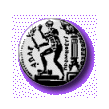
Go to the previous, next section.
Talk
invisible.xbmSometimes email is clumsy and difficult to manage when one really needs to have an interactive conversation. The Internet provides for that as well, in the form of talk. Two users can literally see each other type across thousands of miles.
To talk with Bart Simpson at Widener, one would type
talk bart@cs.widener.edu
which would cause a message similar to the following to be displayed on Bart's terminal:
Message from Talk_Daemon@cs.widener.edu at 21:45 ... talk: connection requested by joe@ee.someplace.edu talk: respond with: talk joe@ee.someplace.edu
Bart would, presumably, respond by typing `talk joe@ee.someplace.edu'.
They could then chat about whatever they wished, with instantaneous
response time, rather than the write-and-wait style of email. To
leave talk, on many systems one would type Ctrl-C (hold down
the Control key and press `C'). Check local documentation to be sure.
There are two different versions of talk in common use today. The
first, dubbed "old talk," is supported by a set of Unix systems
(most notably, those currently sold by Sun). The second, ntalk
(aka "new talk"), is more of the standard. If, when attempting to
talk with another user, it responds with an error about protocol
families, odds are the incompatibilities between versions of talk is
the culprit. It's up to the system administrators of sites which use
the old talk to install ntalk for their users.
Go to the previous, next section.
Copyright © 1998, Software Engineering Laboratory
National Technical University of Athens